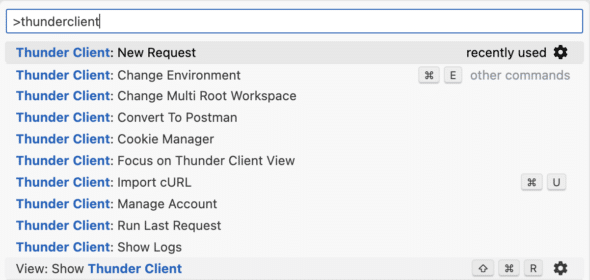Thunder Client is a lightweight REST client for testing your APIs that contains many of the same features as Postman. You might be wondering why you’d switch to Thunder Client if you’re already using something like Postman. I hope this will answer that question.
How do I use it?
Thunder Client is used as an extension directly in your VS Code editor. This provides you with a large set of commands within VS Code for quick access to the Thunder Client’s tools. Some of the most used and powerful commands are the new request command and the run last request command. Also, the “show Thunder Client” command can be useful if you don’t want to have to click your way into the extension.

In the Thunder Client extension panel within VS Code, you’ll see a simple layout with three main tabs: Activity, Collections, and Env. The Activity tab is pretty straightforward and just shows your most recent requests. This is useful for quick access to see what order you made your requests in.
Next, the Collections tab allows you to create collections: groups of requests that share common settings. Within the collection, you can specify a standard group of settings, similar to Postman. This includes the base URL, headers, auth, tests, environments, and a handful of other things.
And finally, the Env tab lets you create a set of environment variables for each of your app’s environments. You can select these same environments within the collection if you want to make requests against dev, QA, prod, or any of your other environments.

Thunder Client also has a CLI tool that lets you make many of the same commands using your command line. You can read more about that here!
What’s the cost difference?
One of the biggest differences between Thunder Client and Postman is the pricing. While both applications have a free tier, the starting price for Postman is five times higher than the starting price of Thunder Client, $3 per user per month against Postman’s $15 per user per month. The features included in each of the “starter” plans vary slightly between the two applications but I think that it’s a negligible difference and Thunder Client allows for more granular pricing with $3, $7, and $16 per user per month pricing at the time of writing.
What If You Don’t Like Thunder Client?
If you use Thunder Client and spend a lot of time setting it up only to find out you don’t like it, don’t fear! There’s a simple solution so you don’t have to redo all your work. That is, simply use the “convert to Postman” command to export a Postman-compatible version of your collections.
I hope I’ve given you enough information to give Thunder Client a shot next time you need to set up a new collection of API requests for testing. Let me know how you like it! And, if you’ve got constructive feedback let the folks at Thunder Client know!

